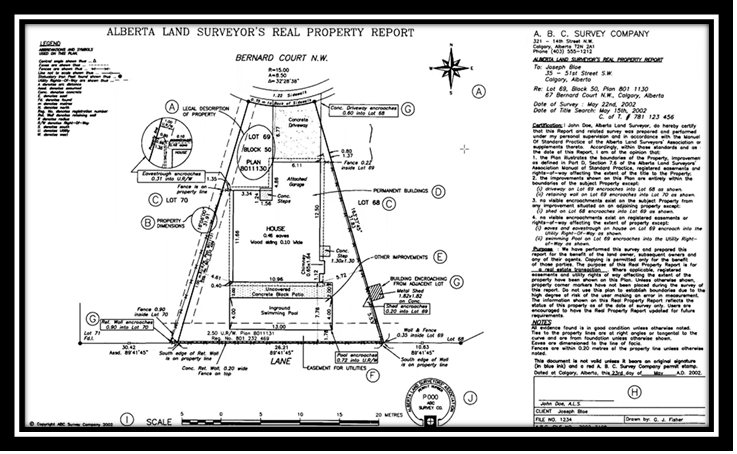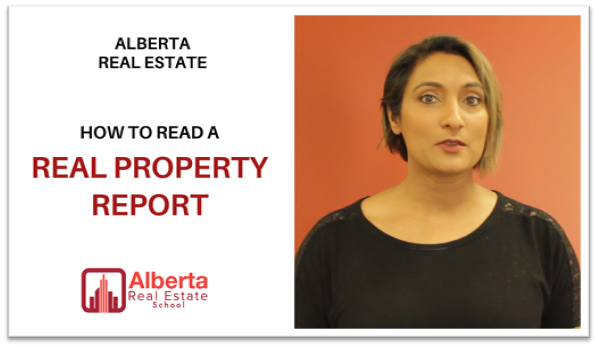A Real Property Report (RPR) is a very important document when selling or purchasing a real estate property. Almost every real estate transaction requires a Real Property Report.
In this article, we’ll go into details about RPR, what is included in an RPR, the different types of RPRs as well as a how to read a real property report with an example.
First, let’s look at an actual Real Property Report and see how to read it.
Example of Real Property Report – Sneak Peak from our Tutoring Sessions
Now, let’s get into the details of the topic.
What is a Real Property Report (RPR)?
An RPR is a legal document prepared by the Alberta Land Surveyor. It’s basically a high-level drawing of the property, highlighting the boundaries of the property. It also showcases the buildings and structures on and beside the property. It also includes the legal description of a property to help us identify the exact location of the property.
An illustration of a Real Property Report (RPR) is shown below –

What does a Real Property Report Include?
A Real Property Report contains a number of important specifications about the property including:
- Legal description and municipal address of the property
- Date of land title search
- Date when RPR was prepared
- Certificate of title (land title) number and names of registered owner(s)
- Location and description of all buildings and structures (E.g., Decks, fences) with dimensions, directions, and distances from the property boundaries
- Location and dimensions of any visible encroachments (i.e., Buildings or structures that are too close or even beyond the property line)
- Designation of adjacent properties, roads, lanes
- Evidence of municipal compliance (i.e., The RPR has been reviewed by your municipality and adheres to all municipal bylaws and regulations. They usually stamp and date compliance directly on the RPR)
- Illustrations of any easements that affect the property
- Certified land surveyor’s duly signed certification and opinion on any concerns
- Copyright of the RPR to the land survey company

Real Estate Terminology
An Easement is a right acquired by one party to use another party’s land. It is an agreement between the property owner and some other party (usually your municipal authority or utility) for them to utilize part of your property as needed.
Types of Real Property Report
There are 2 types of Real Property Reports in Real Estate –
- Current RPR
A Current RPR is an RPR that shows the latest improvements and facts about the property. It allows everyone involved to know if there are any issues with encroachments, easements, or any other non-compliance with municipal bylaws. An accurate municipality compliant RPR is required to complete any property transaction in real estate. - Existing RPR
An Existing RPR is a formerly prepared RPR that shows improvements and property details.
If there have been changes made to the property after the RPR was prepared, the property owner has to contact the surveyor to update the existing RPR or create a new one. In case of changes, only an updated RPR with a compliance stamp can confirm that the property complies with municipal regulations.
Things to Keep in Mind while Reading a Real Property Report
The RPR may show non-compliance items. The property owner will have to resolve the non-compliance issues before the property sale closes. The non-compliance issues can include:
- Encroachments
Encroachment is anything that is built or placed on the adjoining property. An example could a wall surpassing the property boundary.
If a structure encroaches (overlaps) on the adjoining property, the property owner and the adjoining property owner will have to enter into an Encroachment Agreement. In order to do so, the owner of the other property has to agree to allow the encroachment. The encroachment agreement will be registered on both the property titles. If the adjoining owner doesn’t agree, the property owner will have to remove the encroaching structure. - Relaxations
If a structure is built too close or on the municipal (city) property or over an easement or a utility right-of-way, the property owner will have to request a Relaxation Permit from the municipality to allow it. The municipality will conduct a review for the same and may require additional information such as photos of the structure and an extra permit fee.
If the relaxation permit is not granted, the property owner will have to move or remove the structure from the property at their own expense. As part of the sale, the buyer or lender may require a holdback of part of the purchase price or mortgage proceeds until you have a relaxation permit.
Hope you enjoyed the blog and understood the concept of RPR in real estate.
Join Alberta Real Estate School for expert help with understanding the concepts of Real Estate and getting uncommon and detailed tutoring sessions personalized as per your needs.

Get our Focused Study Guides, Exclusive Video Courses and “In-demand” Tutoring Sessions to get you through the Real Estate Exams on the first attempt!
If you have any doubts for Exam Preparation of any of the real estate courses or topics, reach out to us directly at 587.936.7779.
Get Social with us to get updates on other Real Estate Topics!

